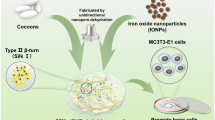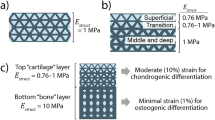Abstract
Fluorescence imaging in vivo can non-invasively monitor and reveal the process of the implants. In this work, it has developed a novel Carbon dots/Hydroxyapatite/PVA (CDs/HA/PVA) dual-network (DN) hydrogel scaffold with excellent fluorescence and biocompatible properties, which have significant importance as implant biomaterials with the demands for less invasive procedures. The composite hydrogel was fabricated by two combined procedures, including firstly chemical crosslinking then physical crosslinking techniques. The composite hydrogel was further characterized by HRSEM, TGA and fluorescence spectrum et al. The results showed that the polymer networks of the CDs/HA/PVA DN hydrogel became more compact and their pore sizes decreased to about 1~3 μm after suffered the freezing/thawing cyclic process. When the mass ratios of CDs to PVA increased from 0.0% to 6.0%, they also exhibited a prominent enhancement of the maximum fluorescence emission intensities. What’s more, the CDs/HA/PVA DN hydrogels had excellent biocompatibility as MC3T3-E1 cells exhibited highly cell viabilities on their surfaces, the relative cell viability was about 91.24% after the MC3T3-E1 cells were incubated with the hydrogels for 5 days. This fluorescence-related hydrogel has potential to be applied in non-invasive monitoring field for the in vivo evaluation of implant biomaterials.




Similar content being viewed by others
References
Ionita M, Crica LE, Tiainen H, Haugen HJ, Vasile E, Dinescu S, Costache M, Iovu H (2016) Gelatin–poly(vinyl alcohol) porous biocomposites reinforced with graphene oxide as biomaterials. J Mater Chem B 4:282–291
Ghasemzadeh H, Ghanaat F (2014) Antimicrobial alginate/PVA silver nanocomposite hydrogel, synthesis and characterization. J Polym Res 21:355
He W, Guo X, Zheng J, Xu J, Hayat T, Alharbi NS, Zhang M (2019) Structural evolution and compositional modulation of ZIF-8-derived hybrids comprised of metallic Ni nanoparticles and silica as interlayer. Inorg Chem 58:7255–7266
Zhang M, Zheng J, Wang J, Xu J, Hayat T, Alharbi NS (2019) Direct electrochemistry of cytochrome c immobilized on one dimensional au nanoparticles functionalized magnetic N-doped carbon nanotubes and its application for the detection of H2O2. Sensors Actuators B Chem 282:85–95
Lu Z, Wang Z, Chen X, Yi L, Gao J, Wei W, Yu L (2011) High strength graphene oxide/polyvinyl alcohol composite hydrogels. J Mater Chem 21:10399–10406
Kumaraswamy S, Mallaiah SH (2016) Swelling and mechanical properties of radiation crosslinked au/PVA hydrogel nanocomposites. Radiat Eff 171:869–878
El-Mohdy HLA, Ghanem S (2009) Biodegradability, antimicrobial activity and properties of PVA/PVP hydrogels prepared by γ-irradiation. J Polym Res 16:1–10
Zhang D, Yang J, Bao S, Wu Q, Wang Q (2013) Semiconductor nanoparticle-based hydrogels prepared via self-initiated polymerization under sunlight, even visible light. Sci Rep 3:1399
Hui Z, Xu F, Jing T, Jing M, Xu L, Wang X, Liu D, Yi W, Liu J (2017) A novel transparent luminous hydrogel with self-healing property. J Mater Chem B 5:5738–5744
Cui X, Wang J, Liu B, Ling S, Long R, Xiong Y (2018) Turning au nanoclusters catalytically active for visible-light-driven CO2 reduction through bridging ligands. J Am Chem Soc 140:16514–16520
Minli Y, Junjie Z, Yuan H, Zhenfeng D, Min L, Feng X (2015) Inkjet printing of upconversion nanoparticles for anti-counterfeit applications. Nanoscale 7:4423–4431
You ML, Lin M, Gong Y, Wang S, Li A, Ji L, Zhao H, Ling K, Wen T, Huang Y (2017) Household fluorescent lateral flow strip platform for sensitive and quantitative prognosis of heart failure using dual-color Upconversion nanoparticles. ACS Nano 11:6261–6270
Wang Y, Ning W, Zhuo Y, Li G, Zhang X (2015) Novel dye-containing copolyimides: synthesis, characterization and effect of chain entanglements on developed electrospun nanofiber morphologies. J Polym Res 22:65
Zhang YY, Wu M, Wang YQ, He XW, Li WY, Feng XZ (2013) A new hydrothermal refluxing route to strong fluorescent carbon dots and its application as fluorescent imaging agent. Talanta 117:196–202
Wang YQ, Xue YN, Li SR, Zhang XH, Fei HX, Wu XG, Sang SB, Li XN, Wei M, Chen WY (2017) Nanocomposite carbon dots/PAM fluorescent hydrogels and their mechanical properties. J Polym Res 24:224
Li H, Kang Z, Liu Y, Lee S-T (2012) Carbon nanodots: synthesis, properties and applications. J Mater Chem 22:24230–24253
Meng H, Gu X, Yang H, Deng Y, Wang C (2016) PVA/carbon dot nanocomposite hydrogels for simple introduction of ag nanoparticles with enhanced antibacterial activity. Macromol Mater Eng 301:1352–1362
HTY K, Ma Z, Wan J, Zhang Y, Kang Z, Liu Z (2012) In vivo NIR fluorescence imaging, biodistribution, and toxicology of Photoluminescent carbon dots produced from carbon nanotubes and graphite. Small 8:281–290
Zhao G, Qing H, Huang G, Genin GM, Lu TJ, Luo Z, Xu F, Zhang X (2019) Author correction: reduced graphene oxide functionalized nanofibrous silk fibroin matrices for engineering excitable tissues. NPG Asia Mater 11:982–994
Tudorachi N, Chiriac AP (2011) Poly(vinyl alcohol-co-lactic acid)/hydroxyapatite composites: synthesis and characterization. J Polym Environ 19:546–558
Chiu DJ, Li Y, Feng CK, Yang MR, Chen KS, Swieszkowski W (2017) Preparation and enhanced mechanical properties of hydroxyapatite hybrid hydrogels via novel photocatalytic polymerization. J Polym Res 24:1–9
Abu-Saied MA, Wycisk R, Abbassy MM, El-Naim GA, El-Demerdash F, Youssef ME, Bassuony H, Pintauro PN (2017) Sulfated chitosan/PVA absorbent membrane for removal of copper and nickel ions from aqueous solutions—fabrication and sorption studies. Carbohydr Polym 165:149–158
Cipreste MF, Sousa EMB (2014) Poly(vinyl alcohol)/collagen/hydroxyapatite nanoparticles hybrid system containing Yttrium-90 as a potential agent to treat osteosarcoma. J Biomater Nanobiotechnol 5:24–30
Hu M, Gu X, Yang H, Wang T, Huang J, Wang C (2016) Low chemically cross-linked PAM/C-dot hydrogel with robustness and Superstretchability in both as-prepared and swelling equilibrium states. Macromolecules 49:3174–3183
Acknowledgements
This work was supported by the National Natural Science Foundation of China (No. 11702183, 11632013, 11572213, 11872262), the State Key Laboratory of Luminescent Materials and Devices (No. 2019-skllmd-21), the State Key Laboratory of Molecular Engineering of polymers (Fudan University) (No. K2019-17).
Author information
Authors and Affiliations
Corresponding authors
Additional information
Publisher’s note
Springer Nature remains neutral with regard to jurisdictional claims in published maps and institutional affiliations.
Rights and permissions
About this article
Cite this article
Wang, Y., Xue, Y., Wang, J. et al. Biocompatible and photoluminescent carbon dots/hydroxyapatite/PVA dual-network composite hydrogel scaffold and their properties. J Polym Res 26, 248 (2019). https://doi.org/10.1007/s10965-019-1907-1
Received:
Accepted:
Published:
DOI: https://doi.org/10.1007/s10965-019-1907-1




